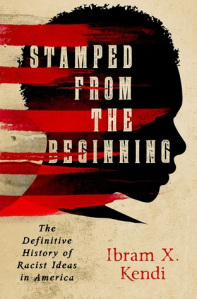Stamped from the Beginning, by Ibram X. Kendi
 This book took me quite a while to read because I had it out as an audiobook from the library, and it’s very long and the loan ran out before I’d finished it. Then it was so popular it was a long wait to check it out again! But finally, in two widely-separated loan periods, I got through this massive, thoroughly researched tome about, as the subtitle says, “The Definitive History of Racist Ideas in America.”
This book took me quite a while to read because I had it out as an audiobook from the library, and it’s very long and the loan ran out before I’d finished it. Then it was so popular it was a long wait to check it out again! But finally, in two widely-separated loan periods, I got through this massive, thoroughly researched tome about, as the subtitle says, “The Definitive History of Racist Ideas in America.”
First, to address one criticism I’ve seen of this book: no, that subtitle is not fully accurate. It is, specifically, the definitive history of anti-Black racism in America, beginning back in the earliest colonial period in what became the United States, and exploring how the importation of enslaved Africans, and the development of racist ideas that were necessary to justify the slave trade, planted the seeds for 400+ years of anti-Black racism in the US.
Ibram X. Kendi’s approach to organizing this book is unique — the book is divided into five sections, each given the name of a different person whose life and ideas had an impact on the development of racism and race relations in America. The five characters are three white men: Puritan preacher Cotton Mather (1663-1728), founding father Thomas Jefferson (1743-1826), abolitionist William Lloyd Garrison (1805-1879); one Black man, sociologist W.E.B. DuBois (1868-1963); and one Black woman, activist Angela Davis (b. 1944). But the sections are not biographies of those writers, thinkers and activists, though in most cases a fair degree of biography does get included: rather, each section of the book is an examination of a time period in American history, and the person whose name heads the chapter is taken as one key thinker among many whose ideas — whether racist or anti-racist — were emblematic of the questions being asked and answers being offered in American race relations during that time period.
It was incredibly helpful to me to have previously read Kendi’s How to be an Antiracist before reading this book, to be familiar with his thesis that it’s not possible to simply be “not racist”: people, policies, and ideas are either actively racist or actively anti-racist, and the same people can be anti-racist at some points in their lives and in some of their ideas, while being racist in other ways by continuing to promote racist ideas and stereotypes (and, Kendi argues, some of these racist ideas are promoted by Black people as well as by well-meaning white people who are trying to be anti-racist — most commonly when they promote ideas he labels “assimilationist” by trying to make Black Americans “fit in” with the standards of white society or somehow come “up” to the level of white people). I found these distinctions he makes really useful, and already understanding how he was using these terms helped me to grasp many of his arguments in this book better than I might have otherwise.
This is a vast, sweeping, ambitious and powerful look at the history of anti-Black racism in the United States, and I would consider it a must-read for anyone interested in this history.



